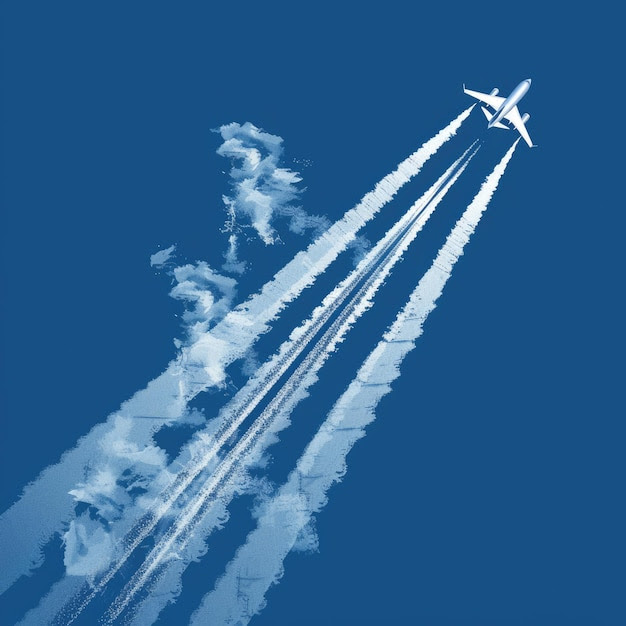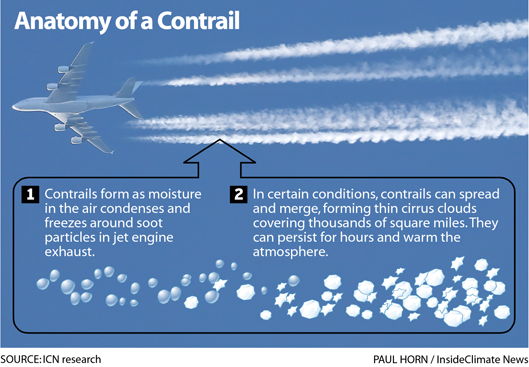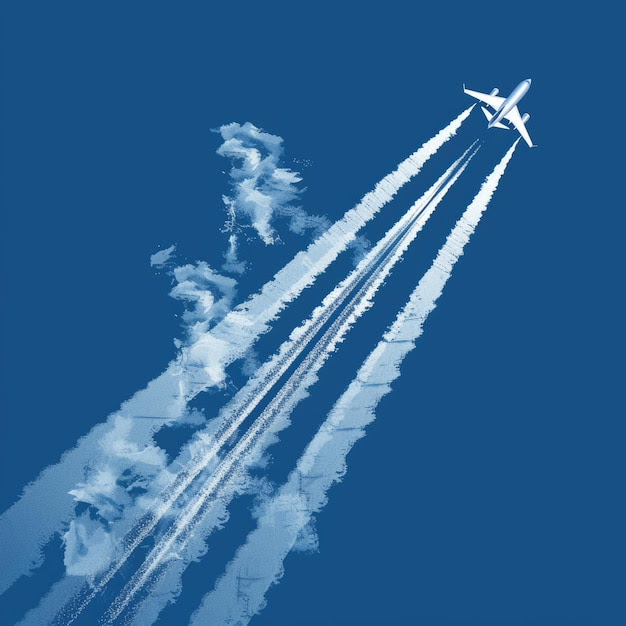
What is the climatic impact of aircraft trails?
High-flying aircraft sometimes leave white streaks in the sky. This phenomenon not only raises legitimate questions among the public, but is also a subject of study for researchers.
The conditions under which aircraft trails form in the sky have been understood since the 1940s, with the work of Schmidt
Schmidt, E., Die Entsheung von Eisnebel aus den Auspuffgasen von Flugmotoren, 1941.
(1941) and Appleman
Appleman, H. , The formation of exhaust condensation trails by jet aircraft, Bull. Am. Meteorol. Soc. 34, 14-20, 1953.
(1953). The thermodynamic theory was later completed by Schumann
Schumann U., On conditions for contrail formation from aircraft exhausts, Meteorol. Z., 35, 4-23, 1996.
(1996) to take into account the efficiency of aircraft engines.

The principle behind contrail formation is simple. Warm, moist air leaving the aircraft engine mixes with colder, drier air in the atmosphere. Under certain conditions of temperature and humidity found only in the upper atmosphere at altitudes of around 10 km at our latitudes, this mixture leads to the condensation of water vapour into liquid water droplets, which then freeze almost instantaneously to form a cloud of small ice crystals.
This condensation phenomenon can also be observed when you exhale air on a cold day and a small cloud forms in front of your mouth. In this case, the cloud evaporates quickly because it is small, and the surrounding air is not saturated with water vapour. In the upper atmosphere, things can be different.
If the upper atmosphere is very dry, there is no formation of aircraft drag. That’s why there are days when we don’t see contrails, even though planes are flying overhead.
If the upper atmosphere is dry, but sufficiently humid for contrails to form, they will quickly evaporate (or rather, sublimate). In this case, the drag is very short-lived.
If the upper atmosphere is humid, but remains undersaturated in relation to the ice, the trail will take longer to sublimate, typically up to half an hour, as it takes time for mixing to take place between the air in the vortex behind the aircraft and its surroundings, and for the ice to sublimate in a more humid environment.

Finally, if the upper atmosphere is over-saturated in relation to the ice, the contrail will continue to develop from the condensation of water vapour in the atmosphere. In this case, it can persist for hours, gradually transforming into a cloud veil. These “artificial” clouds are initially made up of small ice crystals, but after a few hours they become indistinguishable from natural cirrus clouds. They will later disappear as the weather changes.
Two observations are in order. The first is that humidity conditions in the upper atmosphere are highly variable, which is why we can see intermittent aircraft trails. They persist only where the upper atmosphere is wetter or more supersaturated than the ice. The second is that the upper atmosphere can be over-saturated with respect to ice without a “natural” cloud having formed.
This phenomenon, known for a long time, is due to the fact that the formation of the ice crystals that make up so-called “cold” clouds requires the presence of small ice-forming nuclei such as dust or pollen, which are in very low concentrations in the upper atmosphere. The “warm humid air-cold dry air” mixture behind the aircraft short-circuits this natural process, allowing liquid water to condense. It is therefore the aircraft that has triggered the appearance of the trails, but almost all the ice present in the persistent trails comes from water vapour that was already present in the atmosphere.
The humidity of the upper atmosphere is not well predicted, so it’s difficult to anticipate where contrails will or won’t form. It would seem, however, that certain meteorological situations favour the atmospheric conditions necessary for contrail formation. There is no reason to believe that these conditions are becoming more frequent, but it is certain that the number of aircraft has been rising steadily for decades, which in itself increases the likelihood of contrails forming.
Researchers are interested in aircraft contrails because they have a small, but not necessarily negligible, impact on the climate. Aircraft contrails and induced cirrus clouds have a dual impact on the climate: they reflect solar radiation, helping to cool the climate, but they also induce a greenhouse effect, helping to warm it.
The 1999 IPCC report, and virtually all studies conducted since, conclude that the warming effect of the greenhouse effect outweighs the cooling effect of solar radiation reflection. The 2013 IPCC report estimates the radiative forcing of aircraft contrails at +0.01 W.m-2 with a confidence interval of +0.005 to +0.03 W.m-2, and that due to induced contrails and cirrus clouds taken together at +0.05 W.m-2 with a confidence interval of +0.02 to +0.15 W.m-2. This forcing is small compared with that of man-made greenhouse gases (2.7 W.m-2). Even if it is concentrated in certain regions, climate models show that it remains too small to produce observable effects on the climate of our regions (Rap et al.
Notes




